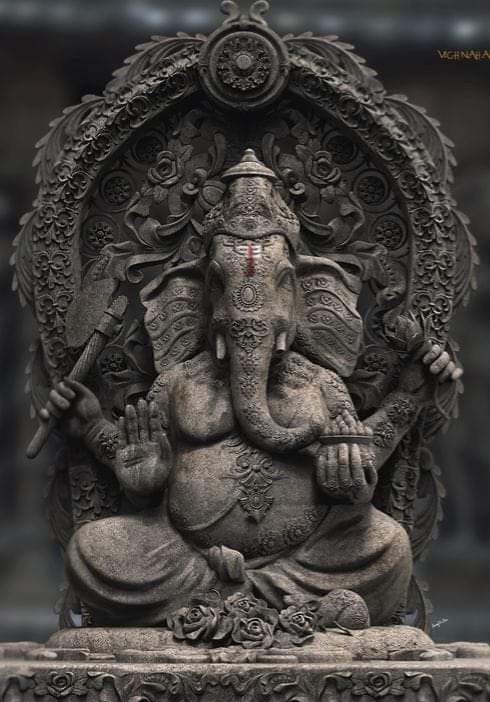If you've ever wondered why Ganesha—the joyful, pot-bellied, sweet-loving Hindu god of wisdom—has the head of an elephant, you're not alone. It’s one of the most beloved and curious features in all of Hindu iconography. Ganesha is instantly recognizable across temples, home shrines, yoga studios, and street murals, and yet his unusual form holds layers of meaning, mystery, and myth.
Let’s take a deep dive into the origin of Ganesha’s elephant head, the stories that surround it, the symbolism behind it, and how this iconic figure continues to inspire people across the globe.
Who Is Ganesha?
Ganesha, also called Ganapati, Vinayaka, or Pillaiyar, is one of the most revered deities in Hinduism. He is the Remover of Obstacles, the God of New Beginnings, and the Patron of Arts and Sciences. Practically every Hindu ritual begins with a prayer to Ganesha, asking for his blessings to ensure success and remove hindrances.
He is the son of Shiva, the cosmic destroyer, and Parvati, the goddess of fertility, love, and power.
But why, of all creatures, did Ganesha end up with an elephant’s head?
The Most Famous Story: A Divine Decapitation
The most widely accepted and beloved version of the story comes from the Shiva Purana, an ancient Sanskrit text rich with mythological lore.
One day, Parvati wished to take a bath. Wanting privacy, she fashioned a boy out of turmeric paste and breathed life into him. This boy—her son—stood guard at the door of her bath and was instructed not to let anyone in.
Just then, Shiva returned from his meditation in the Himalayas. When he tried to enter, Ganesha, dutiful as ever, blocked the doorway. Shiva, unaware that the boy was his son, grew furious at being denied access to his own home. A battle broke out, and in his wrath, Shiva beheaded the boy.
When Parvati discovered what had happened, her grief was so intense that the entire cosmos trembled. To console her and correct his error, Shiva promised to bring the boy back to life. He sent his followers to find the head of the first creature they encountered—an elephant.
With the elephant’s head placed upon the boy’s body and life restored, Ganesha was reborn, not just as Parvati’s son but as a divine being with immense power, revered by gods and mortals alike.
Symbolism: More Than Just a Head Swap
The story is vivid, dramatic, and a little wild—but it’s not just mythological entertainment. Every detail of Ganesha’s appearance is steeped in symbolism.
1. Elephant Head
Elephants are wise, loyal, strong, and deeply intuitive. In Indian culture, elephants also symbolize auspiciousness and royal power. Ganesha’s elephant head stands for wisdom, understanding, and a discriminating intellect that one must possess to attain perfection in life.
2. Large Ears
Ganesha’s enormous ears remind us to listen more and talk less. They also symbolize the importance of open-mindedness—taking in knowledge from all sources.
3. Small Eyes
They represent concentration and the ability to see beyond the apparent.
4. Trunk
His trunk is a marvel—strong enough to uproot a tree, delicate enough to pick up a blade of grass. This symbolizes adaptability and strength combined with sensitivity.
5. One Tusk
Ganesha broke off one tusk and used it as a pen to write the Mahabharata, as dictated by the sage Vyasa. It’s a symbol of sacrifice for the sake of wisdom and the written word.
Even the mouse he rides on symbolizes the ego—small and pesky, but when kept under control, it can be a vehicle of great transformation.
Alternative Versions: Gaze of Shani, Curse of a Sage
The decapitation tale is the most famous, but Hindu mythology has room for many versions. In another story, Shani (Saturn) looked at baby Ganesha with his fiery gaze and his head was incinerated. Again, an elephant’s head was used to restore him.
Yet another tale says that Parashurama, an avatar of Vishnu, struck Ganesha down during a dispute, and his head was replaced with that of an elephant.
These versions reinforce the idea that divine transformation often arises from conflict, loss, or cosmic intervention.
Temples Worth Visiting
Many temples across India and around the world honor Ganesha, but a few are particularly famous for their history and connection to his stories:
Siddhivinayak Temple, Mumbai
One of the most visited temples in India, dedicated to Ganesha as the granter of wishes. Bollywood stars and politicians are regular visitors.
Shree Maha Ganapathi Temple, Kottarakkara, Kerala
This temple links Ganesha to Kerala’s vibrant cultural and spiritual life. The deity here is worshipped in a unique style that blends tradition with regional customs.
Rockfort Ucchi Pillayar Temple, Tamil Nadu
Built atop a massive rock, this temple offers a breathtaking view and a deep sense of serenity. Legend connects it to the story of Ganesha and the divine fruit of knowledge.
Dagdusheth Halwai Ganapati Temple, Pune
Famous for its opulent idol adorned with gold and jewels. The annual Ganesh festival here is a major cultural event.
Ganesha Beyond India
Ganesha’s influence stretches beyond Hindu temples. He appears in Buddhist temples in Southeast Asia, is revered in Jain traditions, and has become a global spiritual icon—gracing everything from yoga studios in California to tattoos in Berlin.
His image speaks across boundaries. He represents the universal themes of overcoming adversity, seeking wisdom, honoring beginnings, and accepting transformation.
Ganesha and New Beginnings
Why is Ganesha always the first god invoked in rituals?
It’s not just tradition—it’s psychological. Starting something new can be intimidating. We fear failure. We worry about obstacles. Ganesha reminds us that every great journey begins with humility, wisdom, and the courage to change.
Whether you’re beginning a new job, launching a creative project, moving to a new place, or just trying to change your mindset, Ganesha whispers: “You’ve got this. Let me help clear the way.”
Want to Read More?
For deeper insights and beautiful storytelling, consider diving into:
• “Myths and Symbols in Indian Art and Civilization” by Heinrich Zimmer – offers interpretations of Ganesha’s iconography.
• “Ganesha: The Auspicious... the Beginning” by Shakunthala Jagannathan & Nanditha Krishna – a visually rich and informative book about Ganesha’s myths and meaning.
• Devdutt Pattanaik’s books – particularly “99 Thoughts on Ganesha”, which presents quick, insightful reflections.
In the End...
Ganesha’s elephant head isn’t just a curious myth—it’s a mirror reflecting the complexities of life. His story tells us that even the most painful transformations can lead to wisdom. That identity isn’t fixed. That obstacles aren’t enemies—they’re teachers.
So the next time you see a little Ganesha statue tucked into a garden or seated in a temple, pause and smile. Behind that joyful elephant face lies a cosmic truth: you too are capable of renewal, reinvention, and wisdom born from change.
|
|







